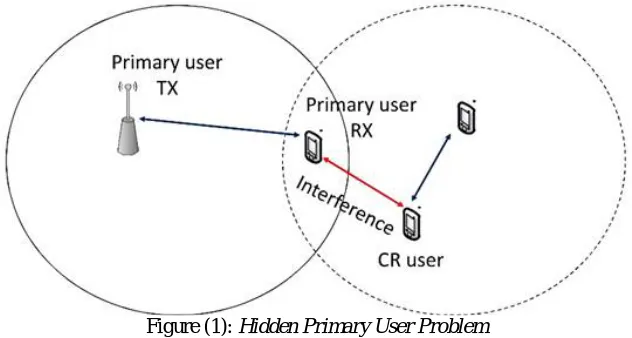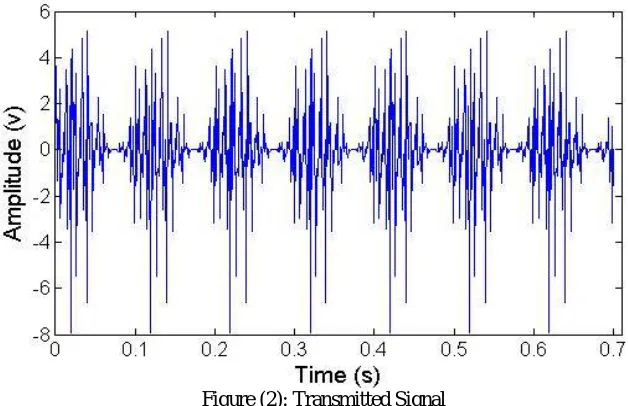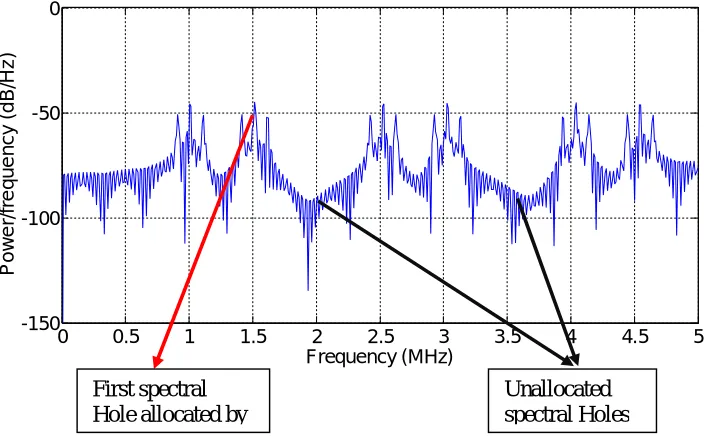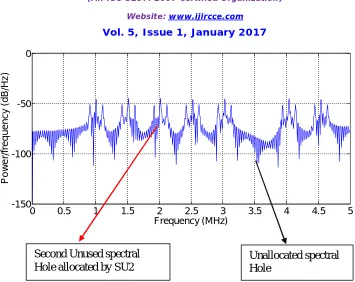Cognitive Radio Spectrum Sensing and
Secondary User Allocation
Emhamed A. Adaba
1, Ehab H. Abdelhy
2, Fayez W. Zaki
3Faculty of Engineering, Department of Electronics and Communications, Azzaytuna University _ Libya1
Faculty of Engineering, Department of Electronics and Communications, Mansoura University _ Egypt2,3
ABSTRACT: The increased demand of services and applications on the wireless communication networks in the future requires wider ranges of spectrum. This enforces the designers to develop new techniques and solutions to use the scarce spectrum efficiently. One of the proposed solutions is moving to new higher frequencies, but it is observed that the licensed spectrum is not completely used where some parts are unused and others are not utilized. Cognitive radio is an intelligent technique used in wireless networks to take advantage of unused or underutilized spectrum. This may be performed by allocating secondary users in the spectrum holes in order to enhance the efficiency of radio resource allocations.
In this paper; spectrum sensing methods and secondary user allocation are performed to utilize the spectrum holes. The simulation Model is carried out using Matlab simulation program in order to study the performance of the proposed cognitive radio system.
KEYWORDS: Cognitive user, Spectrum holes.
I. INTRODUCTION
The dramatically growth of wireless networks and the huge number of connected devices especially in the next generation networks increase the demand on the radio spectrum, which is originally crowded. The spectrum is congested due to using conventional techniques to assign radio resources. In fact with the emerging of the 5G cellular network as dense and heterogeneous networks, the shortage of radio resources will increase rapidly. So that, new techniques must be evolved to cope this increased demand and improve the utilization of radio resources [7].
Cognitive radio is a promising technique to solve the underutilization of the licensed spectrum where secondary users (SU) can randomly use the licensed spectrum if it is free (the primary user is idle) without cause interference to the primary user (PU). One of the important tasks in the cognitive radio system is the spectrum sensing, where the secondary user need to sense the spectrum and check which frequency bands is not used by the primary users and adjust its parameters to use them [8].
In spectrum sensing, the secondary transmitter senses the activity of the primary user and depends on this result he decides if its transmission will effect on the primary user or not. But there is aterminal problem that when the cognitive transmitter cannot sense the primary receiver that be when
The primary receiver closer to the cognitive transmitter.Secondary user devices with very sensitive detection will solve this problem, but it will be very expensive. In order to avoid this problem; the provider must be provide sensing scheme instead in secondary user [9]. Secondary user needs to know more than just spectrum holes it must be detect power/localization of primary user as well to get the best results [10]. Implement cognitive radio system in Matlab and energy detection is used to determine the unused bands and allocate secondary user in this paper.
II. RELATED WORK
reconfigurable frameworks. In any case, in paper [4] authors discussed the primary test is to have the capacity to detecting spectrum hole. In [5] authors discussed overview of spectrum detecting methods. And the difficulties and issues required in execution of spectrum detecting strategies are examined in detail giving near investigation of different approaches. In [6] authors discussed the wide intellectual radio system innovation vision , and Articulate a portion of the key research inquiries and difficulties (i.e., the "science plan") that need to be tended to so as to assemble systems of cognitive radios.
III. SPECTRUM SENSINGS
Cognitive radio (CR) as mentioned above depend on the ability of the cognitive user to detect the spectrum holes and use this holes (unused frequency bands) without interfere with the primary users. Cognitive radio user collect the information from environment and process this information to make its decision, this called cognitive ability, alsoCR must be able to reprogram dynamically according to the collected information from the wireless environment, this property called re-configurability[11].
The first step in the cognitive radio operations is the spectrum sensing, where the CR continuously monitoring the spectrum to determine the spectrum holes and share its information with other CR users. Then, CR determines the best hole to access in which is called Spectrummanagement. Third function is spectrum sharingwhere the CR assign the unused holes to the secondary user as long as the primary user don’t need it. Finally, if the primary user need the channel CR vacate the channel and this property calledcognitive mobility[12].
IV. SPECTRUM SENSING CHALLENGES
Spectrum sensing need cognitive radio devices with high hardware requirements such as; high resolution, analog to digital converters, and high speed digital processors.On the other band, cognitive radio devices need to send in a wide band of frequencies to increase the chance of find free holes. According to this;the improvement of cognitive devices components such as antenna and power amplifiers will be needed, however new technologies such as beam forming and FPGAs will increase the efficiency of cognitive radio devices.
One of the cognitive radio challenges is the Hidden Primary User Problem where the cognitive user can’t detect the primary user signal, figure (1) illustrate this problem.
Figure (1): Hidden Primary User Problem
duration)and the reliability of sensing (sensing frequency). However cognitive radio systems should behas very good sensitive devices of the spectrumto get the best[13].
V. SPECTRUM SENSING TECHNIQUE
Spectrum sensing classified into three main categories, non-cooperative sensing (Transmitter Detection), cooperative sensing and interference based sensing. Non-cooperative sensing also divided into three classes:In these categories; different detection methods will be used.
A. ENERGY DETECTION
The RF energy is measured in the channel by the wireless device in the energy detection to know if the channel is busy or idle. Energy detection used due to its low computational complexity and it is easy to implement. One of the disadvantage of this method, it is only detect the primary user signal if it is above specified threshold, no detection status can occur due to presence of noise [14].
If the received signal in the cognitive radio has the form:
( ) = ( ) + ( ) (1)
Where: ( ) is the signal to be detected and ( ) is the White Gaussian Noise. The equation matric can be written as:
= | ( )| (2)
Where n is the sample index and N is the observation space. Two states will result due to comparing the metric with the predefined threshold .
ℎ , ( ) = ( ) ( < ) (3) ℎ , ( ) = ( ) + ( )( > ) (4)
The threshold parameter must be adjusted to obtain the optimum performance which need to know the detected signal power and the noise. However it is difficult to know the signal power which vary depend on the transmission parameters.
B. MATCHED FILTER DETECTION
Matched filter technique depend on correlating the unknown signals with a time shifted version of the signals. The correlation output is compared with the predefined threshold to determine the presence or absence of primary user. The matched filter criteria can be expressed as
( ) = ℎ( − ) ( ) (5)
Where ( ) is the detected signal andℎ( − ) is shifted version of the impulse response of the matched filter.It is observed that, primary user signal need to be knownin advance, which is practically difficult. Matched filter is optimum method for detecting primary user when transmitted signal is known.Low time required to implement false alarm probability is the main advantage of matched filter detection[15].
Matched filter detection unit implementation complexity is very high, since cognitive radio needdedicatedreceivers for all signal types. Also power consumption is high in matched filter detection due to several algorithms needed.
C. CYCLOSTATIONARY FEATURE DETECTION
VI. SIMULATION AND RESULTS
To study the spectrum sensing and performance of cognitive radio system Matlab simulation is used.
The simulation follow the steps in table 1. In step 4 the spectrum sensing implemented by calculating the power spectral density (PSD) and compare it with predefined threshold. If it is lower than threshold the primary user considered as absence and secondary user allocated to this frequency band.
Table 1: Cognitive Radio System Implementation
1. Initialize 8 signals with amplitude Amand frequencies from 1MHZ to 5 MHZ with 0.5
MHZ difference.
2. Perform amplitude modulation for the eight signals. 3. Add noise and Attenuation to the signals
4. Add the signals to construct the transmitted signal. (plot output)
5. Sense the spectrum using energy detection (plot the power spectral density to show the unused holes)
6. Detect the unused holes and Allocate secondary users to it. (plot the output) 7. Watch the primary user, if its need the channelvacates the channel immediately.
Figure (2) shows the construction of the transmitted signals which is composed of the eight signals after amplitude modulation.
Figure (2): Transmitted Signal
When the cognitive radio detect the free spectrum holes, it is start to allocate them to the secondary users as shown in figure (4-a, b, c).
Figure (3): Power spectral Density shows the absence and presence of primary users
The cognitive radio system search for the first frequency gap and allocate it by secondary user as shown in figure (4-a), where the first hole is filled by the first secondary user signal. Also, figure (4-b,c) show the allocation of the second and third secondary users. In figure (4-c), it is shown that all the spectrum holes are allocated and the cognitive radio system is ready to empty the spectral holes if asked to empty it.
Figure (4-a): Allocate the first secondary user
0 0.5 1 1.5 2 2.5 3 3.5 4 4.5 5
-150 -100 -50 0 Frequency (MHz) P o w e r/ fr e q u e n c y ( d B /H z ) Un-Allocated Bands
0 0.5 1 1.5 2 2.5 3 3.5 4 4.5 5
-150 -100 -50 0 Frequency (MHz) P o w e r/ fr e q u e n c y ( d B /H z ) First spectral Hole allocated by
Figure (4-b): Allocate the Second secondary user
Figure (4-c): Allocate the Third secondary user
VII. CONCLUSION
A practical implementation of cognitive radio system by using Matlab is introduced where some primary users assumed absence and energy detection used efficiently to sense the spectrum and determine the spectrumholes. Secondary users are allocated to these unused holes without interfering with the primary users. The results showed each step of the
0 0.5 1 1.5 2 2.5 3 3.5 4 4.5 5
-150 -100 -50 0
Frequency (MHz)
P
o
we
r/
fr
e
q
u
e
n
c
y
(
d
B
/Hz
)
Second Unused spectral Hole allocated by SU2
Unallocated spectral Hole
0 0.5 1 1.5 2 2.5 3 3.5 4 4.5 5
-150 -100 -50 0
Frequency (MHz)
P
o
w
e
r/
fr
e
q
u
e
n
c
y
(
d
B
/H
z
)
cognitive radio implementation successfully.By using cognitive radio, spectrum holes can be used to improve the capacity of mobile networks.
REFERENCES
[1] Federal Communications Commission, "Facilitating Opportunities for Flexible, Efficient and Reliable Spectrum Use Employing Cognitive Radio Technologies", notice of proposed rulemaking and order, FCC 03-322, December 2003
[2]S. Haykin, “Cognitive radio: Brain-empowered wireless communications,” IEEE J. Select. Areas Common. vol. 23, no. 2, 2005, pp. 201-220 [3] Lars Berlemann, George Dimitrakopoulos, Klaus Moessner, and Jim Hoffmeyer “Cognitive Radio and Management of Spectrum and Radio Resource”, Wireless World Research Forum Working Group 6 White Paper© 2005.
[4] Qing Zhao and Brian M. Sadler “A Survey of Dynamic Spectrum Access”, 1053-5888/07/$25.00©2007IEEE, MAY 2007
[5] Mansi Subhedar1 and GajananBirajdar “SPECTRUM SENSING TECHNIQUES IN COGNITIVE RADIO NETWORKS”: A SURVEYInternational Journal of Next-Generation Networks (IJNGN) Vol.3, No.2, June 2011
[6] Peter Steenkiste, Douglas Sicker, and Gary Minden”Future Directions in Cognitive Radio Network Research” NSF Workshop Report, March 9-10, 2009
[7] M. Subhedar and G. Birajdar, “S Pectrum S Ensing T Echniques in C Ognitive R Adio N Etworks : a S Urvey,” Int. J., vol. 3, no. 2, pp. 37–51, 2011.
[8] Z. Zhang and Y. Wang, “Cognitive R adio S pectrum S ensing F ramework B ased on M ulti -A gent A rchitecture for 5G N etworks,” no. December 2015, pp. 34–39, 2016.
[9] Zhu Han, Rongfei Fan, and Hai Jiang, “Replacement of spectrum sensing in cognitive radio,” IEEE Trans. Wirel. Commun., vol. 8, no. 6, pp. 2819–2826, 2009.
[10] X. Li, Q. Han, V. Chakravarthy, and Z. Wu, “Joint spectrum sensing and primary user localization for cognitive radio via compressed sensing,” Proc. - IEEE Mil. Commun. Conf. MILCOM, pp. 329–334, 2010.
[11] P. D. and S. C. Goutam Ghosh, “Simulation and Analysis of Cognitive Radio System Using MATLAB,” Int. J. Next-Generation Networks, vol. 6, no. 2, pp. 31–45, 2014.
[12] B. V. Jaipur and B. Pahwa, “Simulation of Cognitive Radio Using Periodogram,” Int. J. Eng. Res. Technol., vol. 2, no. 9, pp. 2215–2222, 2013.
[13] T. Yücek and H. Arslan, “A survey of spectrum sensing algorithms for cognitive radio applications,” IEEE Commun. Surv. Tutorials, 2009.
[14] N. Sai Shankar, C. Cordeiro, and K. Challapali, “Spectrum agile radios: Utilization and sensing architectures,” 2005 1st IEEE Int. Symp. New Front. Dyn. Spectr. Access Networks, DySPAN 2005, pp. 160–169, 2005.
[15] R. Tandra and A. Sahai, “Fundamental limits on detection in low SNR under noise uncertainty,” 2005 Int. Conf. Wirel. Networks, Commun. Mob. Comput., vol. 1, pp. 464–469, 2005.
[16] W. a. Gardner, “Signal Interception: A Unifying Theoretical Framework for Feature Detection,” IEEE Trans. Commun., vol. 36, no. 8, pp. 897–906, 1988.



